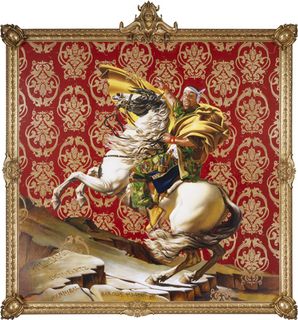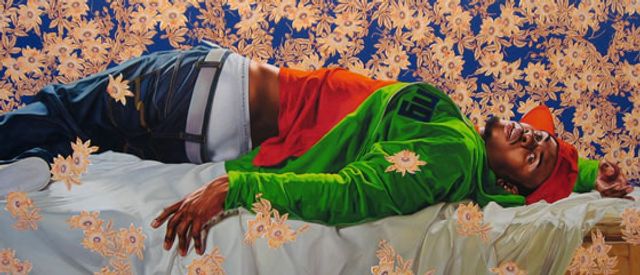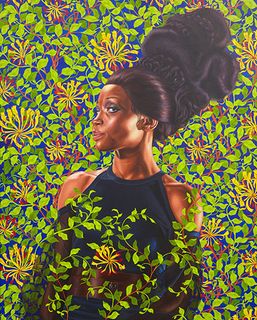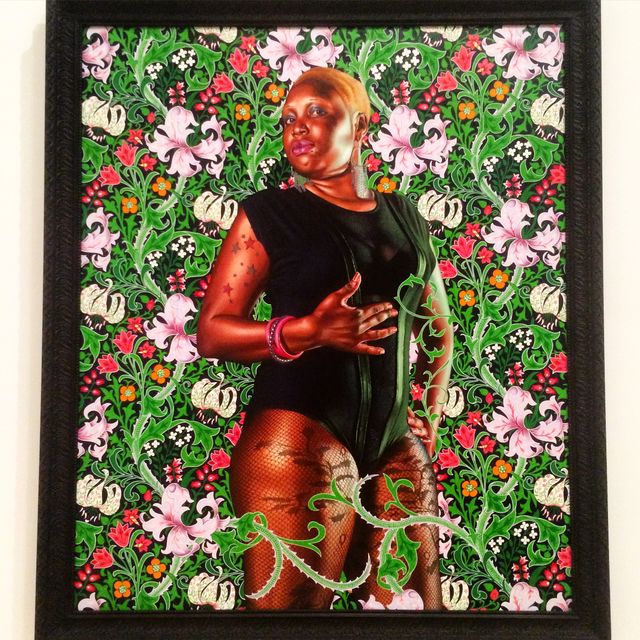Clare Hurley
Kehinde Wiley: A New Republic, an exhibit at the Brooklyn Museum, February 20–May 24, 2015
A New Republic, a retrospective exhibition of American painter Kehinde Wiley’s work at the Brooklyn Museum, accorded the highly successful, 38-year-old artist an exaggerated importance similar to the exaggeration that characterizes his lavishly decorative portraits. In the latter, Wiley copies European Old Masters paintings, substituting African Americans in contemporary, hip hop street garb in the poses of aristocrats and other wealthy figures of power and privilege.
For example, in Wiley’s Napoleon Leading the Army Over the Alps (2005), based on Jacques-Louis David’s equestrian portrait of Napoleon I (1801), an African American “urban warrior” in camouflage pants is substituted for the French general and subsequent emperor. Marx famously observed in The Eighteenth Brumaire of Louis Bonaparte(1852) that “all great world-historic facts and personages appear, so to speak, twice … the first time as tragedy, the second time as farce.” One might add in the case of Wiley’s painting: the third time as kitsch.
 Napoleon Leading the Army Over the Alps (2005)
Napoleon Leading the Army Over the Alps (2005)
Wiley describes how growing up in Los Angeles in the early 1990s, he would spend weekends in the Huntington Museum of Art studying Reynolds, Gainsborough, Rembrandt, van Dyck and others without seeing anyone that “looked like me.” By painting “black and brown” people into the canon of European paintings, Wiley set out to “confront and critique historical traditions that do not acknowledge Black cultural experience.”
However, this approach is thoroughly off base. The reason why one doesn’t find “black and brown” people as the subjects of Old Masters paintings is a historical and social question bound up with the development of world capitalism and bourgeois culture, and not simply a supra-historical manifestation of racial prejudice and exclusion of black cultural experience. Furthermore, how many “average” white art students look at 17th and 18th century paintings of kings and aristocrats, Dutch burghers and prelates and see people that look like themselves in an immediate or superficial sense?
Great artwork, and particularly portraits like those by Rembrandt or van Dyck, Velazquez or van Gogh do resonate across the centuries because they communicate some essential insight into the person and social relations depicted, which are at once historically specific while maintaining an intimate familiarity and meaning to contemporary viewers. To relate to a portrait only on the basis of the color or gender of the sitter is woefully purblind. That Wiley does not see anyone “like himself” in great paintings of the past is a comment on his obtuseness and narrow view. But then, one doesn’t get the impression that Wiley is a terribly profound artist, rather that he hit upon a gimmick and has been handsomely rewarded for it.
He began his semi-controversial “street-casting” method of approaching young, working class African American men in the streets of Harlem and asking them to model based on a historical painting or sculpture of their choosing during an artist residency at the Studio Museum of Harlem after he received an M.F.A. from Yale University in 2001.
Many of these paintings are homoerotic; perfectly polished male subjects gaze at the viewer with languid, come-hither expressions. Often based on a female original, as in Femme piquée par un serpent (2008), this queer “subversion of the male gaze” has won Wiley additional kudos in the sphere of identity politics.
 Femme piquee par un serpent (2008)
Femme piquee par un serpent (2008)
As repainting the canon of Old Masters to include “people of color” grew stale, Wiley expanded his format to include faux gold leaf religious icons and stained glass windows, all featuring young African American men in contemporary street gear in place of the original subject.
Beginning in 2006, he then took his show onto the “World Stage,” traveling to Jamaica, France, Israel, India, Sri Lanka, Brazil, Nigeria, Senegal and China to find an expanded range of “black and brown” subjects. With an entourage of photographers, art apprentices and other assistants, Wiley went into small villages or favelas [Brazilian slums] asking people to adopt poses based not only on art from the Western European tradition, but also from their own cultures, as in Dogon Couple (2008) based on an 18th-19th century wooden statuette from Mali. In Wiley’s painting, the figures are transformed from an archetypal male and female to a pair of men.
In the “World Stage” paintings, the sitters often wear sports shirts, caps and sneakers that were likely mass-produced in their own countries for Western markets. They are placed against backgrounds based on textiles or other indigenous decorative patterns, which reach around to encompass the sitters like overgrown vines. In The White Slave (2010), a young Sri Lankan man sits in a lotus pose, while the background reproduces a 19th century European painting of a white concubine, in case we missed the anti-orientalist message.
Even aside from the simplistic and reactionary identity politics, there are problematic aspects of Wiley’s prolific artistic output. The paintings are repetitive to the point of being formulaic and tedious. Some of them could, and may well be, painted largely by assistants who allegedly work in undercompensated conditions, though Wiley would not be the only contemporary artist to operate an “art factory” to churn out his lucrative work—Jeff Koons, Damien Hirst, Ai Wei Wei all do, too.
 Shantavia Beale II (2012)
Shantavia Beale II (2012)
From an aesthetic standpoint, the artificiality of embedding the sitters within the floral background tends to reduce the figures to another decorative element, and with few exceptions, one gets little sense of connection to the actual person portrayed, as one would with a truly compelling portrait from any time period. Without their own context, the sitters lose cultural and historic specificity. Although they may take pride in being the subject of a painting in a museum, they are not present under their own names or identities.
Conceptually, the idea that removed from their actual surroundings and placed in positions of power, Wiley’s sitters are “empowered” is hogwash. At the end of the day, the sitters return to their streets, villages and favelas, perhaps having received some compensation, while Wiley sells their portraits to wealthy collectors starting at $40,000 for the smaller paintings and up to $150,000 for the large ones.
Nor is Wiley particularly original in painting contemporary people and subjects into Old Masters artwork. Postmodernist painting has employed historical pastiche to various ends, some more, some less successful. In the 1990s, a fellow native of Los Angeles, Sandow Birk painted Death of Manuel of an LA gang leader using the composition of Jacques-Louis David’s famous painting of the French Revolution Death of Marat (1793) and transposed scenes of urban conflict into other 19th century Romantic paintings, including Eugène Delacroix’s Liberty Leading the People (1830).
Another African American artist, Titus Kaphar, recently exhibited The Jerome Project at the Studio Museum of Harlem, a series of portraits of black men all of whom were named Jerome, like Kaphar’s father and who, like him, had been incarcerated. The portraits are on gold leaf panels recalling icons and dipped in tar to cover their mouths, indicating their silencing and disenfranchisement.
Wiley’s portraits have a definite appeal to a certain audience because they show a large range of working class youth who are rarely, if ever, depicted in art. His portraits of women, which he started painting after being criticized for only showing men in positions of power, tend to be more memorable, as are his bronze busts.
 Portrait of Mary Hill, Lady Killigrew (2013)
Portrait of Mary Hill, Lady Killigrew (2013)
Still, one can’t help but ask, what social conditions are these men on horses with their swords or hoodies like cowls, and women in designer gowns aspiring to? As the world’s handful of international High Net Worth Individuals increasingly resembles the aristocracy of the ancien regime, to what social instincts do Wiley’s paintings appeal? Envy seems a reasonable word to introduce into the discussion.
The presentation of “people of color” as noble and beautiful, graceful and confident has been welcomed as “affirmative,” particularly by elements of the aspiring black American middle class. There is nothing remotely “revolutionary” or subversive in Wiley’s paintings. Napoleon, the product of the bourgeois French Revolution, stood for something greater than himself; he represented social relationships and a “cause” that were frightening to feudal Europe. In the way that Wiley has painted his subjects, without social context, they are entirely isolated, self-referential, unthreatening in any important sense. The painter manages to remove everything penetrating and even critical from the originals.
Whereas the revolutions of the 17th and 18th centuries “required recollections of past world history in order to smother their own content” (Marx), the revolutions of the 21st century will have no use for the “trappings of empire and power” that Kehinde Wiley’s paintings celebrate. The challenge that confronts today’s artists of every color and gender is to find meaningful ways to make use of the cultural developments of the past, in order to create something urgent, contemporary and enlightening.
No comments:
Post a Comment